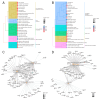Transcript-Level Biomarkers of Early Lung Carcinogenesis in Bronchial Lesions
- PMID: 38927965
- PMCID: PMC11202239
- DOI: 10.3390/cancers16122260
Transcript-Level Biomarkers of Early Lung Carcinogenesis in Bronchial Lesions
Abstract
Premalignant lesions within the bronchial epithelium signify the initial phases of squamous cell lung carcinoma, posing challenges for detection via conventional methods. Instead of focusing solely on gene expression, in this study, we explore transcriptomic alterations linked to lesion progression, with an emphasis on protein-coding transcripts. We reanalyzed a publicly available RNA-Seq dataset on airway epithelial cells from 82 smokers with and without premalignant lesions. Transcript and gene abundance were quantified using kallisto, while differential expression and transcript usage analysis was performed utilizing sleuth and RATs packages. Functional characterization involved overrepresentation analysis via clusterProfiler, weighted coexpression network analysis (WGCNA), and network analysis via Enrichr-KG. We detected 5906 differentially expressed transcripts and 4626 genes, exhibiting significant enrichment within pathways associated with oxidative phosphorylation and mitochondrial function. Remarkably, transcript-level WGCNA revealed a single module correlated with dysplasia status, notably enriched in cilium-related biological processes. Notable hub transcripts included RABL2B (ENST00000395590), DNAH1 (ENST00000420323), EFHC1 (ENST00000635996), and VWA3A (ENST00000563389) along with transcription factors such as FOXJ1 and ZNF474 as potential regulators. Our findings underscore the value of transcript-level analysis in uncovering novel insights into premalignant bronchial lesion biology, including identification of potential biomarkers associated with early lung carcinogenesis.
Keywords: WGCNA; biomarker; bronchial premalignant lesion; cilium; transcriptomics.
Conflict of interest statement
The authors declare no conflicts of interest. The funders had no role in the design of the study; in the collection, analyses, or interpretation of data; in the writing of the manuscript; or in the decision to publish the results.
Figures




References
-
- Sethi S., Oh S., Chen A., Bellinger C., Lofaro L., Johnson M., Huang J., Bhorade S.M., Bulman W., Kennedy G.C. Percepta Genomic Sequencing Classifier and decision-making in patients with high-risk lung nodules: A decision impact study. BMC Pulm. Med. 2022;22:26. doi: 10.1186/S12890-021-01772-4. - DOI - PMC - PubMed
-
- Beane J., Mazzilli S.A., Tassinari A.M., Liu G., Zhang X., Liu H., Buncio A.D., Dhillon S.S., Platero S.J., Lenburg M.E., et al. Detecting the Presence and Progression of Premalignant Lung Lesions via Airway Gene Expression. Clin. Cancer Res. 2017;23:5091–5100. doi: 10.1158/1078-0432.CCR-16-2540. - DOI - PMC - PubMed
Grants and funding
LinkOut - more resources
Full Text Sources

